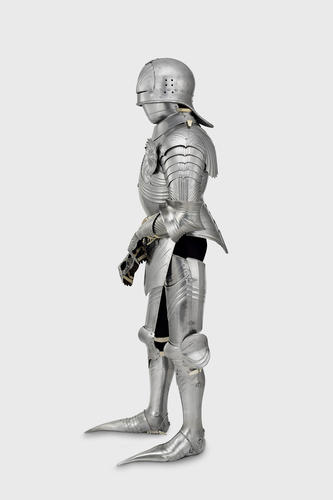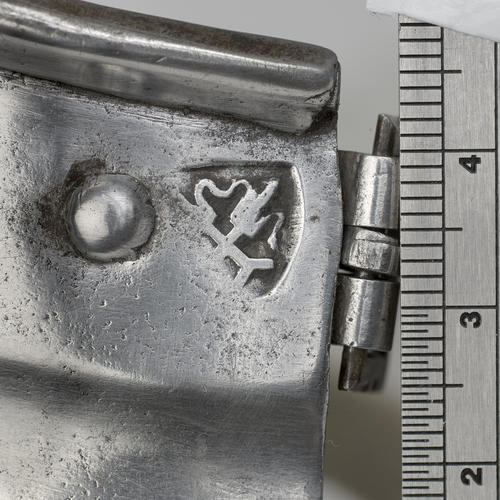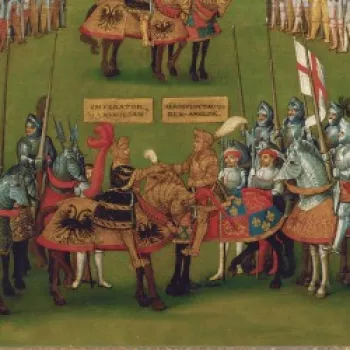Composite cap-a-pie field armour of the Marquess of Waterford mostly early 19th century in the late 15th-century style
Steel, leather | RCIN 71650

Composite cap-a-pie field armour of the Marquess of Waterford mostly early 19th century in the late 15th-century style

Composite cap-a-pie field armour of the Marquess of Waterford mostly early 19th century in the late 15th-century style

Composite cap-a-pie field armour of the Marquess of Waterford mostly early 19th century in the late 15th-century style

Composite cap-a-pie field armour of the Marquess of Waterford mostly early 19th century in the late 15th-century style

Composite cap-a-pie field armour of the Marquess of Waterford mostly early 19th century in the late 15th-century style

Composite cap-a-pie field armour of the Marquess of Waterford mostly early 19th century in the late 15th-century style






-
Composite cap-a-pie field armour comprising heavy jousting sallet (Rennhut) formed with a hemispherical crown rising to a low broad medial comb, extending backwards to a rounded ‘tail’, cut at its front with a single broad vision-slit, reinforced at its lower edge with an applied half-round strip and overlain at the brow with a pair of reinforcing-plates loosely held in place beneath a medial spring-strip; bevor formed of four articulated plates respectively covering the lower face, the chin, the throat and the base of the neck, the last projecting down to a V-shaped central point fastened by means of a projecting peg to a staple fitted at the top of the breastplate; gorget of four lames front and rear; heavy breastplate formed of a main plate and plackart, the former fitted with applied stop-ribs at the edges of its neck and arm-openings and pierced at the right of the chest with holes for the attachment of a lance-rest, and the latter medially ridged, rising to an elaborately fretted point at the centre of its upper edge and flanged outwards at its lower edge to receive a fauld of three upward-overlapping lames, the lowest of which is fitted at either side with a pair of straps for the suspension of a one-piece tasset that tapers slightly to its obtusely pointed lower edge; backplate of four downward-overlapping lames, the uppermost of which is deeper than the rest and fitted within its neck-opening with a separate V-shaped gusset, and the lowest of which is flanged outwards to receive a deep culet of four upward-overlapping lames.
Spaulders each of six lames overlapping outwards from the second and articulated at its lower end to a three-piece vambrace formed of a gutter-shaped upper cannon, pointed shell-like couter open at its rear, and tubular lower cannon opening at its rear; besagues each of dished oval form rising to a boss at its centre and decorated with flutes radiating from it to a cusped edge; gauntlets each formed of a long pointed cuff open at its inside and marked at its upper edge with a pair of crossed sceptres within an escutcheon, wrist-plate embossed over the end of the ulna, two metacarpal plates, shaped knuckleplate, two shaped finger-plates and a hinged thumb-defence of two plates; cuisses each formed of a medially ridged and laterally boxed gutter-shaped main plate fitted at its upper edge with three crescentic extension-lames, at its outer edge with a twice-boxed side-plate, and at its lower edge with a poleyn of four lames overlapping outwards from the second, which is shaped to the point of the knee (repaired in the case of the right) and projects backwards at its outside as a large oval wing, the lower edge of the last lame descending to an acute central point; greaves each of tubular form opening at their insides and cut away over the heel and the top of the foot; and sabatons each formed of a rear section of one plate covering the heel, and a front section of five backward-overlapping lames covering the top of the foot, the front one forming a rounded toe-cap over which is fitted a considerably longer and more pointed, detachable toe-cap.
All parts, with the exception of the sallet, bevor, greaves and sabatons, extensively decorated with fluting in the ‘Gothic’ fashion and cusped at their subsidiary edges. The bevor, gorget and one besague each engraved internally with the initials of James L. Jackson and the date 1958, and the first two further struck internally with the mark of the Conservation Department of the Tower of London Armouries.
The greaves probably sixteenth century but modified to their present form in the early nineteenth century; the bevor, gorget and one besague made in 1958; the remainder, with the possible exception of the tassets which appear to be later replacements, early nineteenth century in the late fifteenth-century style.
Text adapted from Arms and Armour in the Collection of Her Majesty The Queen: European Armour, London, 2016Provenance
Worn by Henry Beresford, Marquess of Waterford at the Eglinton Tournament of 1839. The event, organised by the 13th Earl of Eglinton and staged at Eglinton Castle, Ayrshire, marked a high point in British aristocratic interest in medieval notions of chivalry. Much of the armour for the tournament was supplied by the Bond Street dealer Samuel Pratt. This armour was subsequently purchased from Pratt for the Tower of London Armouries, and transferred to Windsor Castle in 1901.
-
Medium and techniques
Steel, leather
Category
Object type(s)
Other number(s)
Alternative title(s)
Armour in the Gothic style worn by the Marquess of Waterford .








